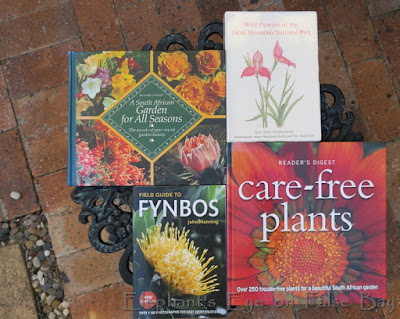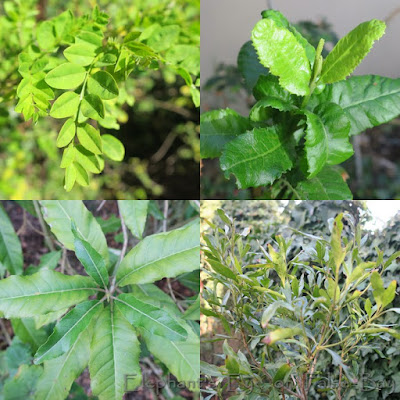Four favourite garden books and our tiny urban forest
by Diana Studer
- gardening for biodiversity
in Cape Town, South Africa
My 2015 post about garden
books still draws readers, but these four are what I use. Mary Maytham Kidd - Wild
Flowers of the Table Mountain National Park - new edition 2006 - 2 editions have accompanied mountain hikes and
all 3 of my gardens. Indigenous is what I aim for, with the familiar and loved
commonorgarden plants in 2 Reader's Digest books. A South African Garden for All Seasons - 1993. And. Care-free Plants - for a Beautiful
South African Garden - 2006. But botanists are always at work on taxonomy and
especially for our Fynbos
Rambles in 2018 I added John
Manning - Field Guide to Fynbos (not an affiliate link!)
We chose our Porterville
garden for the borrowed mountain scenery and 2 thirty year old ash trees.
This False Bay garden was again chosen for green and trees (the house was also
promising) the tall carob in the corner, and a long Coprosma repens x2 hedge were here. Tiny urban forest now with ...
44 trees!
UPDATE: 45 with Maurocenia frangula in August
 |
| Tiny urban forest in our False Bay garden Bauhinia, Dombeya, carob, Hibiscus, Coprosma, Tarchonanthus |
Every evening Ceratonia
siliqua is filled with birds who roost in the carob overnight. One of VERY
few neighbourhood choices for them! A male tree with funky flowers for bees, no
pods. Two more gifts - vibrant orange leaves from fiddlewood Citharexylum
spinosum, and of course the lemon
tree.
My own choices are to support biodiversity. For birds, red
trumpet flowers for sunbirds, then berries on Halleria lucida (laughing Lucy) x3. Feeding
garden Acraea caterpillars on Kiggelaria africana (wild peach)
I love grey leaves.
Flashing between shiny bottle green above and grey velvet below Brachylaena
discolor x2 is cut back frequently. In our tapestry hedge on our
verge Buddleja saligna x2. Flowers and fragrant leaves from Tarchonanthus
camphorbush.
In a mostly green garden, glossy leaves light up the gloom.
My first choice is Diospyros whyteana x2. Small lemon yellow flowers on Psychotria capensis lemoenbos x2. Kei
apple Dovyalis caffra. Inherited hedge of Coprosma repens.
Green needs appealing leaves. Left Hibiscus tiliaceus x2 heart leaves, autumn colours (if it is
cold enough!) and yellow buds fading thru orange to russet flowers. Centre and
above right Bauhinia bowkeri small butterfly leaves and white
flowers. Below right Dombeya burgessiae large graceful leaves with
hanging bells of pink cupped flowers.
Indigofera
trusses of mauvy pink. Pappea capensis bushveld cherry is related to
litchi. Nuxia floribunda forest elder with whorls of 3 leaves. Pavetta
lanceolata forest bride's bush.
Searsia leptodictya x2 long pale leaves. Searsia crenata x7 small
dark leaves, scalloped edge. Olea x2 wild olives.
Not technically a tree, but fitting the gardener's
definition of 'a tree is something you can sit under' Strelitzia nicolai. Also the bietou volunteers in our tapestry
hedge Osteospermum moniliferum x2
Filling out the corners Ficus
benjamina x2 and Searsia glauca. Battling along Calpurnia aurea and Dais cotonifolia.
And my bookshelf. Trees
of Southern Africa - Keith Coates Palgrave. Field Guide to Insects of South Africa - Mike Picker. Birds of the South Western Cape - Joy Frandsen. Birds of Southern Africa - Ian Sinclair.
Roberts' Birds of Southern Africa. South
Africa's Proteaceae - Marie Vogts.
With PlantZAfrica and iNaturalist keeping up with changing
taxonomy.
I invite you to join us at Elephant's Eye on False Bay.
Please subscribe as you prefer
via Feedly,
or Bloglovin,
Teal blue text is my links.
To read comments if you are in email or a Reader,
first click
thru to the blog)
Thanks for comments that add value. Your comment will not
appear until I've read it. No Google account? Use Anonymous, then please
include a link to your own blog. I welcome comments on posts from the last 2
months.










Urban forest indeed! Forty-four trees/tree-like shrubs is significant. Counting several large shrubs but excluding our extensive hedges, we have 34. If it were up to me, I'd plant more but that foolish community "view conservation" ordinance effectively prevents me from acting on that impulse.
ReplyDeleteYou have more space than me. Ours are shoehorned in and standing on each other's toes.
DeleteI am trying a different way of commenting, as I have not had success with my Google account. Your trees look very healthy and surviving very well in a medium size garden. Hope you are surviving with no chance to get out and walk or jog or run. That must be very hard. However, it is all for our safety, so worth it.
ReplyDeleteThat works - with a link back to your blog, thank you.
Deletehttps://www.canberrasgreenspaces.com/
This night owl may have to try getting up to walk to the sunrise over the sea - and an afternoon nap to recover.
My many ash trees succumbed to the emerald ash borer. I hope you don't have that pest in South Africa! P. x
DeleteNot so many ash trees here.
DeleteBut we do have polyphagous shothole borer - which menaces both commonorgarden and indigenous trees.
Forty four is a lot! And how wonderful to have them in your own garden so you can sit under them too! I can see a lot of trees from my house but they are in other people's grounds. I still count myself fortunate that I can enjoy them and it's part of the pleasure of having moved to my current house. Having trouble this morning while reading blogs because it's reminding me of the things I am missing during a 'shielded' lockdown - ('shielded' being the UK category for people who are not to leave their houses at all). I find I am missing horse chestnut trees - which are currently in flower . . . and plovers and larks. Do you have horse chestnut trees in South Africa?
ReplyDeleteIn theory my husband should absolutely stay at home - at least away from people. It is complicated!
DeleteThere is an avenue of horse chestnuts on one of the approach roads to Kirstenbosch.
I am noticing the fragrance more when I walk laps.
ReplyDeleteDear Diana,
ReplyDeleteyou are doing a great job on birds and biodiversity. Urban forest, what a great job and idea. Trees are wonderful partners also for us humans. I'm a lucky person to have you around. To anwer your question. Yes, indeed, it's the old stoven from my grand mother. She used it once...
Happy days and enjoy your lovely trees and good reading
Elisabeth
We grow so many fabulous South African plants in California, but now seeing your hikes though the wild lands and many unfamiliar plants in your garden, we in California have barely touched on all the floristic wonders of your country.
ReplyDelete44 trees--wow! You are fortunate to be able to grow citrus outdoors year-round. My lemon tree must come indoors from October through May, and it's not happy right now with the transition. I really enjoyed your foliage collages--they are beautiful and showcase the diversity in your garden!
ReplyDelete"something you can sit under" is actually quite a good definition of a tree. And by that standard not all so called trees where I live qualifies.
ReplyDeleteWhat an amazing variety of leaf colours and shapes - and textures.
ReplyDeleteThank you so much for adding your little urban forest to the tree following link box - very welcome!
Take care :)